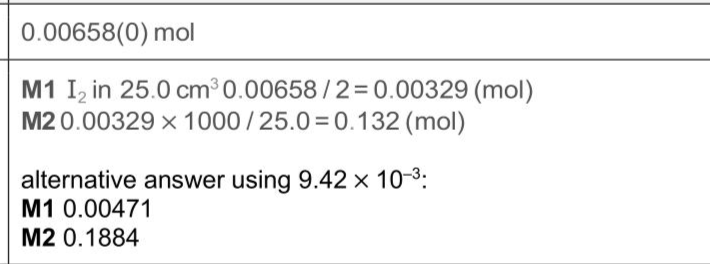$$\(3 \quad \mathrm{H}_{2}(\mathrm{~g})\)$$ and $$\(\mathrm{I}_{2}(\mathrm{~g})\)$$ react to form $$\(\mathrm{HI}(\mathrm{g})\)$$ in a reversible reaction, as shown in equation 1. In three separate experiments, a student combines different amounts of two or more of the gases from equation 1. In each experiment, the gases are left to reach equilibrium at a given temperature. In experiment 1, $$\(\mathrm{H}_{2}(\mathrm{~g})\)$$ and $$\(\mathrm{I}_{2}(\mathrm{~g})\)$$ are combined. Water is then added to the equilibrium mixture to produce $$\(1.00 \mathrm{dm}^{3}\)$$ of solution $$\(\mathbf{A}\)$$. The amount of $$\(\mathrm{I}_{2}(\mathrm{aq})\)$$ present in $$\(1.00 \mathrm{dm}^{3}\)$$ of solution $$\(\mathbf{A}\)$$ is found by titration with $$\(\mathrm{Na}_{2} \mathrm{~S}_{2} \mathrm{O}_{3}(\mathrm{aq})\)$$. Exactly $$\(32.90 \mathrm{~cm}^{3}\)$$ of $$\(0.200 \mathrm{~mol} \mathrm{dm}^{-3} \mathrm{Na}_{2} \mathrm{~S}_{2} \mathrm{O}_{3}\)$$ reacts with all of the $$\(\mathrm{I}_{2}\)$$ in a $$\(25.0 \mathrm{~cm}^{3}\)$$ sample of solution A. $$\[ \mathrm{I}_{2}(\mathrm{aq})+2 \mathrm{~S}_{2} \mathrm{O}_{3}^{2-}(\mathrm{aq}) \rightarrow 2 \mathrm{I}^{-}(\mathrm{aq})+\mathrm{S}_{4} \mathrm{O}_{6}^{2-}(\mathrm{aq}) \]$$ (i) Calculate the amount, in mol , of $$\(\mathrm{S}_{2} \mathrm{O}_{3}{ }^{2-}\)$$ that reacts in the titration. $$\[ \text { amount of } \mathrm{S}_{2} \mathrm{O}_{3}{ }^{2-}=\ldots \ldots \ldots \ldots \ldots \ldots . . . . . . . . . . . . . . . . \mathrm{mol} \text { [1] } \]$$ (ii) Use your answer to (a)(i) to calculate the amount, in mol, of $$\(I_{2}\)$$ present in $$\(1.00 \mathrm{dm}^{3}\)$$ of solution A. (If you were unable to obtain an answer in (a)(i), then use $$\(9.42 \times 10^{-3} \mathrm{~mol}\)$$. This is not the correct answer.) amount of $$\(I_{2}\)$$ in $$\(1.00 \mathrm{dm}^{3}\)$$ of solution $$\(\mathbf{A}=\)$$ mol
Exam No:9701_s25_qp_24 Year:2025 Question No:3(a)
Answer:

Knowledge points:
2.4.1.1 reacting masses (from formulae and equations) including percentage yield calculations
2.4.1.2 volumes of gases (e.g. in the burning of hydrocarbons)
2.4.1.3 volumes and concentrations of solutions
2.4.1.4 limiting reagent and excess reagent (When performing calculations, candidates’ answers should reflect the number of significant figures given or asked for in the question. When rounding up or down, candidates should ensure that significant figures are neither lost unnecessarily nor used beyond what is justified (see also Mathematical requirements section).) deduce stoichiometric relationships from calculations such as those in 2.4.1 (1)–(4)
Solution:
Download APP for more features
1. Tons of answers.
2. Smarter Al tools enhance your learning journey.
IOS
Download
Download
Android
Download
Download
Google Play
Download
Download
